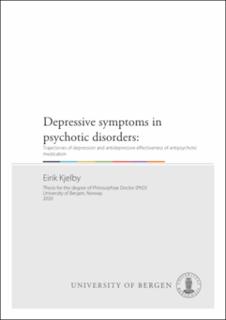| dc.contributor.author | Kjelby, Eirik | |
| dc.date.accessioned | 2020-10-22T13:03:58Z | |
| dc.date.issued | 2020-10-16 | |
| dc.date.submitted | 2020-09-24T13:09:44.127Z | |
| dc.identifier | container/94/fb/60/11/94fb6011-22f2-4792-8ce0-91fe59219ed8 | |
| dc.identifier.isbn | 9788230855522 | |
| dc.identifier.isbn | 9788230841198 | |
| dc.identifier.uri | https://hdl.handle.net/1956/24160 | |
| dc.description.abstract | Background: Depressive symptoms are common in psychotic disorders and contribute to impaired functioning, a poorer quality of life, elevated relapse rate and suicide risk. Depression in schizophrenia may emerge as part of the prodromal phase, preceding and during a psychotic episode and as post-psychotic depression. Early studies indicating dysphoric effects of antipsychotics have been superseded by studies demonstrating antidepressive properties for several atypical antipsychotics. Atypical antipsychotics may exert their antidepressive effects through antagonism at serotonergic 5HT2 receptors, agonism at 5HT1 receptors, antagonism at adrenergic α2 receptors and inhibition of trans-membrane monoamine transporters. Guidelines for the treatment of depression in psychotic disorders remain unclear due to unresolved issues related to among others, the heterogeneity of depression in psychosis, thus more studies are needed. To investigate differences in antidepressive effectiveness, we conducted comparative trials of atypical antipsychotics funded independently of the pharmaceutical industry.
Methods: Change in depressive symptom sum score measured by Calgary Depression Scale for Schizophrenia was investigated in two separate randomized clinical trials, analysed by means of Linear Mixed Effects models and Latent Growth Curve modelling. Trajectories of depressive symptom change were identified with Growth Mixture Modelling.
Results: In the first paper we found depressive symptom reduction that was not significantly different between the atypical antipsychotics olanzapine, quetiapine, risperidone and ziprasidone in a 24-month, industry-independent, randomized trial of 226 patients acutely admitted with psychosis, although olanzapine had the smallest reduction and risperidone the greatest. There were no significant effectiveness differences in the patients with most pronounced depression neither. A much larger drop-out than assumed reduced statistical power. Still, effectiveness differences were smaller than considered clinically relevant.
In the second paper from the same trial we investigated heterogeneity in treatment response and found three depression-trajectories: one depressed and treatment refractory group (14.7%), one group with limited depressive symptoms (69.6%) and a third depressed but early responding group (15.7%). A reduction of positive psychotic symptoms predicted depression improvement. Post-psychotic depression did not emerge in patients that were not depressed in the acute phase and we could not identify differentiating characteristics of the depression trajectories.
The third paper investigated the antidepressive effectiveness of the atypical antipsychotics amisulpride, aripiprazole and olanzapine in a second randomized clinical trial. In 144 patients no between-drug differences in depressive symptom reduction were found, although the amisulpride group had the greatest depressive symptom reduction. The majority of depressive symptom reduction occurred within 6 weeks. No antidepressive effectiveness differences between the study drugs were found in the group with most pronounced depression, neither. Statistical power was smaller than power-analyses indicated due to discrepancies between presumed and actual study characteristics.
Conclusion: We conclude that the net effectiveness of atypical antipsychotics during and following psychotic episodes on group-level is antidepressive and not depression-inducing. Since no head-to-head antipsychotic antidepressive differences were found, we can make no recommendations concerning choice of any particular atypical antipsychotic for targeting symptoms of depression in patients acutely admitted with psychosis. The treatment-refractory patients are candidates for enhanced anti-depressive treatment, for which current evidence is limited. For a substantial portion of patients treatment as usual of the psychotic episode was sufficient to reduce acute-phase depression. | eng |
| dc.language.iso | eng | eng |
| dc.publisher | The University of Bergen | eng |
| dc.relation.haspart | Paper I: Kjelby E, Jørgensen HA, Kroken RA, Løberg EM, Johnsen E (2011): Antidepressive
effectiveness of olanzapine, quetiapine, risperidone and ziprasidone: a
pragmatic, randomized trial. BMC Psychiatry, 2011 Aug 31; 11:145. The article is available at: <a href="http://hdl.handle.net/1956/5489" target="blank">http://hdl.handle.net/1956/5489</a> | eng |
| dc.relation.haspart | Paper II: Kjelby E, Gjestad R, Sinkeviciute I, Kroken RA, Løberg, E-M, Jørgensen HA,
Johnsen E (2018): Trajectories of depressive symptoms in the acute phase of
psychosis: Implications for treatment. J Psychiatr Res, 2018 Aug; 103; 219-228,
doi: 10.1016/j.jpsychires.2018.06.003. The article is not available in BORA. The article is available at: <a href="https://doi.org/10.1016/j.jpsychires.2018.06.003" target="blank">https://doi.org/10.1016/j.jpsychires.2018.06.003</a> | eng |
| dc.relation.haspart | Paper III: Kjelby E, Gjestad R, Løberg EM, Reitan SK, Joa I, Larsen TK, Rettenbacher M,
Fathian F, Sinkeviciute I, Alisauskiene R, Anda LG, Berle JØ, Fasmer OB, Kroken
RA, Johnsen E: Antidepressive effectiveness of amisulpride, aripiprazole and olanzapine: a
pragmatic, randomized trial. The article is not available in BORA. | eng |
| dc.rights | Attribution (CC BY) | eng |
| dc.rights.uri | https://creativecommons.org/licenses/by/4.0/ | eng |
| dc.title | Depressive symptoms in psychotic disorders : Trajectories of depression and antidepressive effectiveness of antipsychotic medication | eng |
| dc.type | Doctoral thesis | eng |
| dc.date.updated | 2020-09-24T13:09:44.127Z | |
| dc.rights.holder | Copyright the Author. | eng |
| dc.contributor.orcid | 0000-0003-3964-7971 | |
| fs.unitcode | 13-24-0 | |
| dc.date.embargoenddate | 2023-10-16 | |

